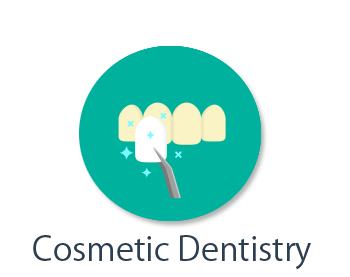Cosmetic Dentistry
Smile Makeover
Smile makeover is that process where cosmetic dental procedures like porcelain veneers, all ceramic crowns, teeth recontouring,gum contouring, tooth whitening, gum de-pigmentation are performed on several front teeth in order to produce an overall change in the appearance of your smile.
Teeth whitening
Dental bleaching, also known as tooth whitening, is a common procedure in general dentistry but most especially in the field of cosmetic dentistry. A child’s deciduous teeth are generally whiter than the adult teeth that follow. As a person ages the adult teeth often become darker due to changes in the mineral structure of the tooth, as the enamel becomes less porous.Teeth can also become stained by bacterial pigments, foodstuffs and tobacco. Certain antibiotic medications (like tetracycline) can also cause teeth stains or a reduction in the brilliance of the enamel. There are many methods to whiten teeth: bleaching strips, bleaching pen, bleaching gel, laser bleaching, and natural bleaching.
Veneers
Veneers are thin custom-made porcelain shells designed to fit discreetly over the teeth, making them indistinguishable from our natural teeth. Veneers may be used for modifying the color or position of teeth. Good quality tooth enamel, preferably intact enamel, is required for successful bonding. Veneers can either be made from porcelain or from resin composite materials.
Benefits of Veneers: Veneers improve the appearance of one’s teeth in the following situations:
- Discoloured teeth due to root canal treatment, stains from medication, excessive fluoride or other causes, or large resin fillings that have resulted in the tooth being discoloured
- Worn down teeth
- Broken or chipped teeth
- Uneven, misaligned or irregularly shaped teeth
- Gaps between teeth
Crowns and bridges
What are Crowns?
Crowns are restorations that cover or cap teeth, restoring them to their natural size, shape, and color. Crowns are indicated when there is a need to strengthen teeth that are mechanically weakened (e.g. teeth with large cavities). Crowns may also be used for modifying the colour or position of teeth.
Benefits of Crowns
Crowns not only helps appearance, but can also save a tooth that might otherwise be lost. Restores structural integrity to your tooth and improves its appearance.Corrects teeth that is discoloured or badly shaped. Covers and supports a tooth in the following situations: where there is not enough tooth left for a filling.to attach a bridge; .to protect a weak tooth from breaking or even restore one that is already broken;. to cover a dental implant.
What are Bridges?
Dental bridges, which are also known as fixed partial dentures, are used to replace one or more missing teeth and are attached to the adjacent natural teeth or dental implants. Benefits of Bridges Bridges not only restore appearance, they also restore dental function by replacing missing teeth.Bridges look like your natural teeth and enable you to chew and bite just like your own teeth .They prevent neighbouring teeth from moving into the gap left by missing teeth. Bridges also improve speech by closing up gaps between teeth easily remove it.
Porcelain filling
What are porcelain filling/ inlay/on lay? An inlay is similar to a filling and lies inside the cusp tips of the tooth. They are custom-made to fit the prepared cavity and are then cemented into place. An onlay is a more extensive reconstruction that covers one or more cusps of a tooth. Onlays are indicated in situations where a substantial reconstruction is required. However, more of the tooth structure can be conserved compared to the placement of a crown. To repair damage involving over of the tooth’s biting surface, rather than using a simple filling, or a crown, a dentist will often use a porcelain inlay or onlay.
Tooth jewellery
Diamonds are forever, Skyce® is just for fun.
What is Skyce®?
Skyce® is jewels, which are specially designed for teeth. The jewellery is applied to teeth in the same way as orthodontic brackets – a procedure which has been around for a long time. Your teeth do not have to be cut or drilled.
What does the procedure involved? First tooth is carefully clean at a small spot on your tooth Then a special fluid applied to this spot in order to microscopically roughen the tooth surface. This enables the adhesive to stick properly. Then the stone is placed on the tooth and adhesive is dried with blue light. In some cases, small amounts of adhesive residue may have to be removed, but this procedure – like the rest of the treatment – is painless. If in the future you no longer want the tooth jewellery, your dentist can easily remove it.



